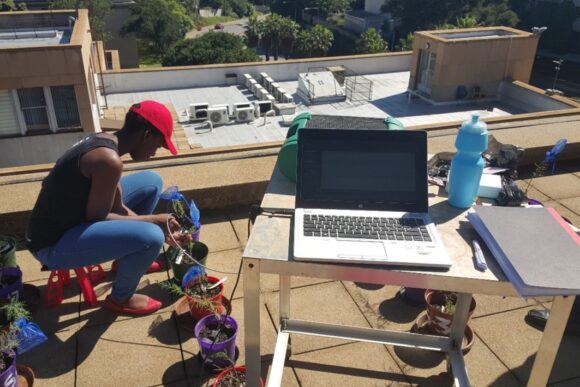6 December 2021 | By Solomon Tesfamichael
Remotely-sensed spectral data enable the identification of native, exotic and hybrid Tamarix taxa found in South Africa. This was affirmed by Solomon Tesfamichael (University of Johannesburg), Solomon Newete (Agricultural Research Council), Elhadi Adam and C·I·B Core Team member, Prof Marcus Byrne (both of the University of the Witwatersrand) using spectral signatures gathered from Tamarix seedlings grown at the University of the Witwatersrand’s biocontrol nursery.
Exotic Tamarix species threaten the integrity of South Africa’s riparian ecology by overexploiting base resources and by replacing the native Tamarix species. The timely inventory of the type and distribution of the invasive Tamarix species is key for a successful mitigation of the problem; however, existing techniques are inefficient due to cost, or inability to differentiate between species with closely related traits.
Spectral data of multiple samples representing native (T. usneoides), exotic (T. ramosissima and T. chinensis) and hybrids (T. chinensis × T. usneoides and T. chinensis × T. ramosissima) Tamarix taxa were analyzed to determine if the species can be distinguished accurately. Furthermore, the spectral data were used to simulate commonly used satellite-based images to explore the scalability of the method.
All the five Tamarix taxa were discerned spectrally and conclusively at high levels of accuracy. Simulated satellite data were also robust in accurately differentiating between the species, suggesting the utility of earth observation data to successfully map the spatial distribution of the trees. Overall, the study proved the applicability of remote sensing for rapid classification of Tamarix species that have similar morphological and functional traits.
“Spectral profiling of plant species is advancing rapidly owing to improvements in remotely sensed data and computer-aided classification skills,” says Solomon Tesfamichael. “We, therefore, need to intensify translating the technology to inform the fight against tree invasions that pose a serious threat to native species and ecosystem services.”
Read the full paper
Solomon G. Tesfamichael, Solomon W. Newete, Elhadi Adam, Marcus J. Byrne. 2021. Discriminating pure Tamarix species and their putative hybrids using field spectrometer. Geocarto International. DOI: 10.1080/10106049.2021.1983033.
For more information, contact Solomon G. Tesfamichael at sgtesfamichael@uj.ac.za or Solomon W. Newete at newetes@arc.agric.za.

